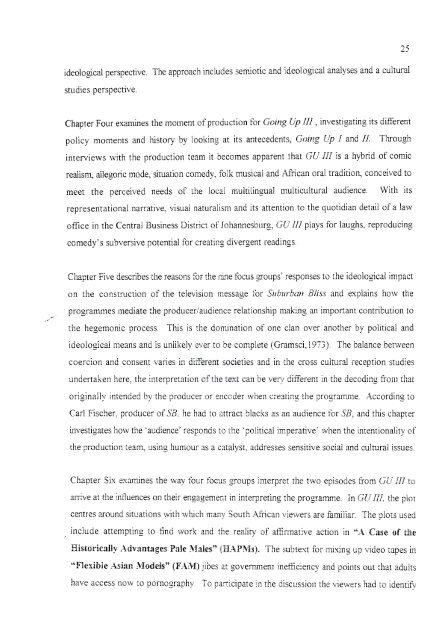View/Open - ResearchSpace
View/Open - ResearchSpace
View/Open - ResearchSpace
Create successful ePaper yourself
Turn your PDF publications into a flip-book with our unique Google optimized e-Paper software.
,r .'"<br />
ideological perspective. The approach includes selT'jotic and ideological analyses and a cultural<br />
studies perspective.<br />
Chapter Four examines the moment of production for Going Up III, investigating its different<br />
policy moments and history by looking at its antecedents, Going Up I and II. Through<br />
interviews with the production team it becomes apparent that GU III is a hybrid of comic<br />
realism, allegoric mode, situation comedy, folk musical and African oral tradition, conceived to<br />
meet the perceived needs of the local multilingual multicultural audience. With its<br />
representational narrative, visual naturalism and its attention to the quotidian detail of a law<br />
office in the Central Business District of Johannesburg, GU III plays for laughs, reproducing<br />
comedy's subversive potential for creating divergent readings.<br />
Chapter Five describes the reasons for the nine focus groups' responses to the ideological impact<br />
on the construction of the television message for Suburban Bliss and explains how the<br />
programmes mediate the producer/audience relationship making an important contribution to<br />
the hegemonic process. This is the domination of one clan over another by political and<br />
ideological means and is unlikely ever to be complete (Gramsci,1973). The balance between<br />
coercion and consent varies in different societies and in the cross cultural reception studies<br />
undertaken here, the interpretation of the text can be very different in the decoding from that<br />
originally intended by the producer or encoder when creating the programme. According to<br />
Carl Fischer, producer of SB, he had to attract blacks as an audience fur SB, and this chapter<br />
investigates how the 'audience' responds to the 'political imperative' when the intentionality of<br />
the production team, using humour as a catalyst, addresses sensitive social and cultural issues.<br />
Chapter Six examines the way four focus groups interpret the two episodes from GU III to<br />
arrive at the influences on their engagement in interpreting the programme. In GU III, the plot<br />
centres around situations with which many South African viewers are familiar. The plots used<br />
include attempting to find work and the reality of affirmative action in "A Case of the<br />
Historically Advantages Pale Males" (HA.PMs). The subtext for mixing up video tapes in<br />
"Flexible Asian Models" (FAM) jibes at government inefficiency and points out that adults<br />
have access now to pornography. To participate in the discussion the viewers had to identify<br />
25

















